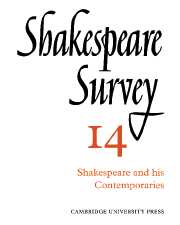Book contents
- Frontmatter
- Studies in Elizabethan and Jacobean Drama since 1900
- Shakespeare and Lyly
- Shakespeare and Mundy
- Marlowe as Provocative Agent in Shakespeare’s Early Plays
- The Tragedy of Revenge in Shakespeare and Webster
- The Simplicity of Thomas Heywood
- The Tragic Vision of Fulke Greville
- Shakespeare v. The Rest: The Old Controversy
- Shakespeare’s Gentleness
- Milton on Shakespeare
- An Unrecorded Elizabethan Performance of Titus Andronicus
- Stratford-upon-Avon a Hundred Years Ago
- International Notes
- Shakespeare Productions in the United Kingdom: 1959
- Three Directors: a Review of Recent Productions
- The Year's Contributions to Shakespearian Study 1 Critical Studies
- 2 Shakespeare’s Life, Times and Stage
- 3 Textual Studies
- Books Received
- Index
- Plate section
The Tragedy of Revenge in Shakespeare and Webster
Published online by Cambridge University Press: 28 March 2007
- Frontmatter
- Studies in Elizabethan and Jacobean Drama since 1900
- Shakespeare and Lyly
- Shakespeare and Mundy
- Marlowe as Provocative Agent in Shakespeare’s Early Plays
- The Tragedy of Revenge in Shakespeare and Webster
- The Simplicity of Thomas Heywood
- The Tragic Vision of Fulke Greville
- Shakespeare v. The Rest: The Old Controversy
- Shakespeare’s Gentleness
- Milton on Shakespeare
- An Unrecorded Elizabethan Performance of Titus Andronicus
- Stratford-upon-Avon a Hundred Years Ago
- International Notes
- Shakespeare Productions in the United Kingdom: 1959
- Three Directors: a Review of Recent Productions
- The Year's Contributions to Shakespearian Study 1 Critical Studies
- 2 Shakespeare’s Life, Times and Stage
- 3 Textual Studies
- Books Received
- Index
- Plate section
Summary
Some comparison between Shakespeare and Webster as writers of tragedy is made possible by their having both written tragedies based upon a type which was very popular in their day. It is true that a dramatic critic in the Observer has recently issued the warning that ‘it is altogether too late for anyone to treat Hamlet simply as a revenge play’. Yet the meaning Hamlet has for us is inseparable from that traditional plot which gives it its unity of structure. It is with some observations about the structure of Hamlet that I begin.
The typical revenge plot, in its barest essentials, is one in which a crime is committed, usually a murder, and vengeance is wrought upon the perpetrator of the deed. The dramatic action therefore centres upon the opposition between the avenger and the murderer, the hero and the villain. In the old Danish story of Hamlet, as we know it from Saxo Grammaticus and as it was retold by Belleforest in Shakespeare's lifetime, a king was murdered by his brother, and the avenging of such a crime, notwithstanding all that may have been said by some Elizabethan preachers and some modern scholars, is regarded by the story as a natural duty devolving upon the murdered man's son. To provide a cover for his designs of vengeance the Prince in the story pretends to be mad, and to get behind his guard of madness his uncle has recourse to various plots. First there is the woman who is employed to try to get his secret from him; next there is the King's counsellor who hides in the Queen's chamber; and finally there are the King's two ministers who escort Hamlet to England to be killed. It is obvious that we have here already adumbrated the roles of Ophelia, Polonius, and Rosencrantz and Guildenstern, and these all originate in that move and counter-move between the hero and the villain which gives the action of Shakespeare's play its excitement and its form.
- Type
- Chapter
- Information
- Shakespeare Survey , pp. 45 - 55Publisher: Cambridge University PressPrint publication year: 1961

